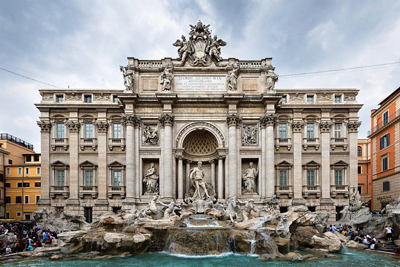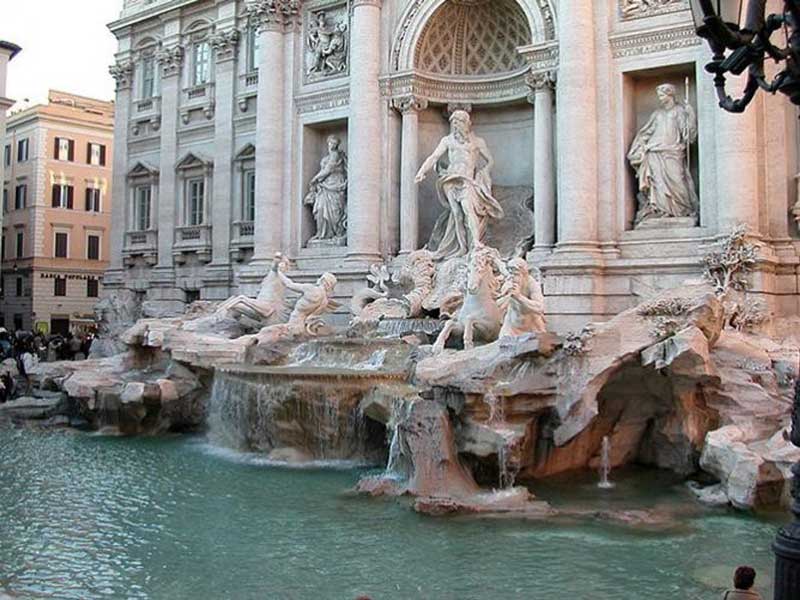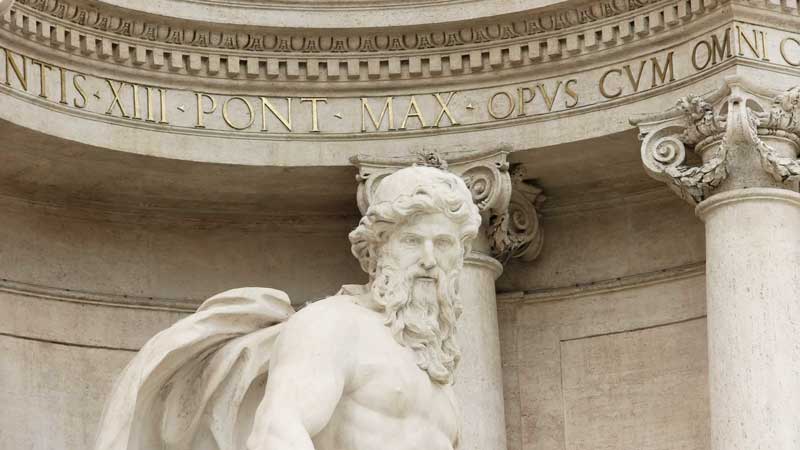
Standing around 86 feet (26.3 m) high, 161.3 feet (49.15 m) wide and intricately decorated in the Baroque style, the Trevi Fountain is the most iconic fountain of Rome and one of the most captivating sights in the city. The name of Trevi derives from Tre Vie (three ways), since the fountain is located at the junction of three roads and more specifically it is built upon the terminus of the Acqua Vergine, one of Rome’s most important aqueducts that supplies drinking water to the Eternal City. In 19th BC Marcus Vipsanius Agrippa transformed the old Aqua Virgo to the modern Acqua Vergine aqueduct, intending to provide quality public services to the citizens.

Since ancient times, there existed a fountain at the site of the wonderful Trevi fountain. As that fountain was insufficiently dramatic, in 1629 Pope Urban VIII commissioned Gian Lorenzo Bernini to sketch its possible renovations. However, the project was abandoned when the pope died. After a century, Pope Clement XII held a contest to re-design the fountain in 1730 and Alessandro Galilei of Florence won the contest. But, due to the outcry in Rome over a Florentine having won, the Roman architect Nicola Salvi was ultimately awarded the project.
Construction of the new fountain began under Salvi’s direction in 1732 and unfortunately, Selvi died in 1752, leaving his work half done. It took another ten years to complete the project, when four sculptures were hired to complete the fountain's decorations and Giuseppe Pannini was hired as the architect. The construction of Trevi fountain was finished in 1762. Many unfortunate workers were injured and a few died during its construction, including a stone-cutter who was crushed by a large block of travertine in 1734.


Regarded as a true jewel of water and stone, the Trevi fountain is intricately carved out mainly of Travertine stone, quarried near Tivoli. Decorated with majestic columns and rows of windows, the top of the fountain is crowned with the Papal Coat of Arms, suspended by the angels.

In the centre of the fountain, a robustly built triumphal arch is superimposed on the palazzo façade. There are four statues at the balustrade representing the four seasons, like Abundance of Fruit, Fertility of the Fields, the Gifts of Autumn and the Amenities of Meadows and Gardens. The centre of the fountain depicts a seashell carriage driven by two tritons commanding sea horses. The central figure is Oceanus or Neptune, with slightly waved hair and a full beard. He is holding a scepter symbolising his authority of water and wrapped in drapery.
Below the gods are the tritons, one of which blows a conch, conduct the winged chariot. One of the horses is calm and the other restive, implying constant motion and fluctuating moods of the sea. Oceanus is flanked by Abundance or Fertility and Salubrity or Health. Abundance is depicted as spilling water from her urn and Salubrity holds a cup from which a snake drinks. The dramatic representations of these sculptures are the characteristics of newer Baroque styles.


It is popularly said that throwing a coin over your left shoulder into the fountain ensures your return to Rome. More than a million Euros in coins are thrown into the fountain each year, which are collected for charity. It is illegal to fish out coins from the fountain. However, in the past some people used to sweep the coins out of the fountain at night and three of them were caught in 2011, by a TV show using a hidden camera. The most famous raider, who stole the coins from the fountain for 34 years, was also caught in the summer of 2002.
Trevi fountain has appeared in numerous notable films, including ‘Roman Holiday’ (1953), starring Gregory Peck, Audrey Hepburn and Federico Fellini's ‘La Dolce Vita’ (1960), starring Marcello Mastroianni and Anita Ekberg. The fountain was draped in black crepe to honor actor Marcello Mastroianni upon his death in 1996.

The fountain uses a closed circuit water system and all of a sudden, one day in 2007, its water turned red, as a vandal dumped a liquid into it. However, the water was drained out quickly enough, before any damage was done.

In 1988, the fountain was refurbished to remove discoloration caused by smog and in 1998, the stonework was scrubbed and all cracks and other areas of deterioration were repaired. In the recent past, the restoration work sponsored by the Italian fashion company Fendi, began in June 2014 and completed in November 2015, which included the installation of LED lights for the better illumination of the beautiful fountain.